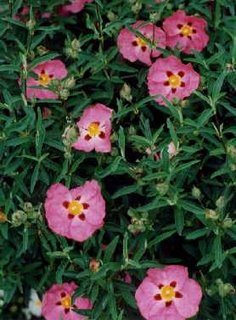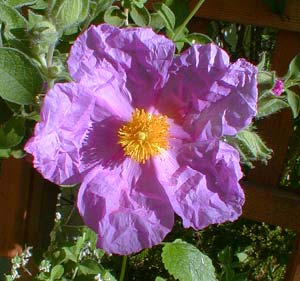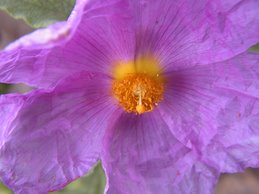
LADANUM (CTAKTH [ADEFL], RESINA),
Gen. 37251 (RYE. MYRRH) 4311t (EV MYRRH), is the
name of a resin called by the Arabs Lidhan or ladan‘
which was yielded by some species of Cistus. It was
known to the Greeks as early as the times of Herodotus
and Theophrastus by the names X+Sov, hdSuvov, and
h.?Suvor, which are very closely allied to the Arabic
name.
Ladanum is described by Herodotus (3 1x2) as particulaFly
fragrant, though gathered from the beards of goats, on which
it is found sticking ; similarly Dioscorides (1 128). Tournefort,
in modern times (Voyage, 129)) has given a detailed description
of the mode of obtaining ladanum. He relates that it is now
gathered by means of a Aasavronjpmv or kind of flail2 with
which the plants are threshed. When these thongs are
loaded with the fiagrant and sticky resin they are scraped
with a knife. the substance is then roiled into a mass,
in which state‘it is called ladanum or labdanum. Ladanum
consists of resin and volatile oil, and is highly fragrant, and
stimulant as a medicine but is often adulterated wlth sand in
commerce. The ladan& which is used in Europe is collected
chiefly in the Greek isles, and also in continental Greece. It
is yielded by species of the genus Cistus (especially by C.
weticus) which are known in this country by the name of Rock
Rose ; they are natives of the S. of Europe, the Mediterranean
islands, and the N. of Africa. According to Tristram (FFP
235) Palestinian ladanum is derived from Cisfus villosus L.,
which grows ‘in the hill district; E. and W. of Jordan,’ ahd is
‘especially plentiful on Carmel. Cistus creticus, which LS only
a varietyof this and distinguished by its yiscidity, is fthe
common formon the southern hdls.’ [Fonck thmks of the C~strrs
salv’uifoo(ius, which is also plentiful on Carmel, for the ladanum ;
but H. Christ (ZDPV 65fi [1899]) questions this identification.]
Ladanum is said by Pliny. as it was long before said by
Herodotus, to be a product of Arabia, though this has not
been proved to be the case in modern times. Enoi~gh,
however, has been adduced to show that Zadanum was
known to, and esteemed by, the ancients ; and, as it is
1 According to Moidtmann and Muller (Sub. Dfnk. 84) the
ZEdhan is the proper Arabic form derived from Persian.
2 Specimens of the implement can be seen in the Museum at
Kew (Crete and Cyprus).
Page 2692
stated to have been a product of Syria, it was very
likely to have been sent to Egypt both as a present and
as merchandise. The word Zridan is found in the inscription
on a S. Arabian censer (Sa6. Denk. 84). and
in Assyrian in the list of objects received as tribute from
Damascus byTiglath-Pileser 111. (KA TC2) 151, 18). The
biblical narrative (J) shows that was some precious
gum produced in Canaan or at least in Gilead.
See Royle's article ' Lot' in Kitto's Bibl. Cycl., on which this
article is mainly based. N. M.-W. T. T.-
page 2963
http://www.case.edu/univlib/preserve/Etana/encyl_biblica_l-p/laadah-lazarus.pdf
Myrrh
Myrrh - Heb. mor.
(1.) First mentioned as a principal ingredient in the holy anointing oil (Ex. 30:23). It formed part of the gifts brought by the wise men from the east, who came to worship the infant Jesus (Matt. 2:11). It was used in embalming (John 19:39), also as a perfume (Esther 2:12; Ps. 45:8; Prov. 7:17). It was a custom of the Jews to give those who were condemned to death by crucifixion "wine mingled with myrrh" to produce insensibility. This drugged wine was probably partaken of by the two malefactors, but when the Roman soldiers pressed it upon Jesus "he received it not" (Mark 15:23). (See GALL .)
This was the gum or viscid white liquid which flows from a tree resembling the acacia, found in Africa and Arabia, the Balsamodendron myrrha of botanists. The "bundle of myrrh" in Cant. 1:13 is rather a "bag" of myrrh or a scent-bag.
(2.) Another word lot is also translated "myrrh" (Gen. 37:25; 43:11; R.V., marg., "or ladanum"). What was meant by this word is uncertain. It has been thought to be the chestnut, mastich, stacte, balsam, turpentine, pistachio nut, or the lotus. It is probably correctly rendered by the Latin word ladanum, the Arabic ladan, an aromatic juice of a shrub called the Cistus or rock rose, which has the same qualities, though in a slight degree, of opium, whence a decoction of opium is called laudanum. This plant was indigenous to Syria and Arabia.
http://www.htmlbible.com/kjv30/easton/east2632.htm
Myrrh
NET Glossary: a reddish-brown resinous material, the dried sap of the myrrh tree, Commiphora myrrha or Balsamodendron, an ingredient of perfumes and incense highly prized in ancient times and often worth more than its weight in gold; myrrh was also used as an ingredient in embalming ointment
Myrrh [EBD]
Heb. mor. (1.) First mentioned as a principal ingredient in the holy anointing oil (Ex. 30:23). It formed part of the gifts brought by the wise men from the east, who came to worship the infant Jesus (Matt. 2:11). It was used in embalming (John 19:39), also as a perfume (Esther 2:12; Ps. 45:8; Prov. 7:17). It was a custom of the Jews to give those who were condemned to death by crucifixion "wine mingled with myrrh" to produce insensibility. This drugged wine was probably partaken of by the two malefactors, but when the Roman soldiers pressed it upon Jesus "he received it not" (Mark 15:23). (See GALL.)
This was the gum or viscid white liquid which flows from a tree resembling the acacia, found in Africa and Arabia, the Balsamodendron myrrha of botanists. The "bundle of myrrh" in Cant. 1:13 is rather a "bag" of myrrh or a scent-bag.
(2.) Another word lot is also translated "myrrh" (Gen. 37:25; 43:11; R.V., marg., "or ladanum"). What was meant by this word is uncertain. It has been thought to be the chestnut, mastich, stacte, balsam, turpentine, pistachio nut, or the lotus. It is probably correctly rendered by the Latin word ladanum, the Arabic ladan, an aromatic juice of a shrub called the Cistus or rock rose, which has the same qualities, though in a slight degree, of opium, whence a decoction of opium is called laudanum. This plant was indigenous to Syria and Arabia.
Myrrh [NAVE]
MYRRH, a fragrant gum. A product of the land of Canaan, Song 4:6, 14; 5:1.
One of the compounds in the sacred anointing oil, Ex. 30:23.
Used as a perfume, Esth. 2:12; Psa. 45:8; Prov. 7:17; Song 3:6; 5:13.
Brought by wise men as a present to Jesus, Matt. 2:11.
Offered to Jesus on the cross, Mark 15:23.
Used for embalming, John 19:39.
Traffic in, Gen. 37:25; 43:11.
MYRRH [SMITH]
This substance is mentioned in (Exodus 30:23) as one of the ingredients of the "oil of holy ointment:" in (Esther 2:12) as one of the substances used in the purification of women; in (Psalms 45:8; Proverbs 7:17) and in several passages in Canticles, as a perfume. The Greek occurs in (Matthew 2:11) among the gifts brought by the wise men to the infant Jesus and in (Mark 15:23) it is said that "wine mingled with myrrh" was offered to but refused by, our Lord on the cross. Myrrh was also used for embalming. See John 19;39 and Herod. ii. 86. The Balsamodendron myrrha , which produces the myrrh of commerce, has a wood and bark which emit a strong odor; the gum which exudes from the bark is at first oily, but becomes hard by exposure to the air. (This myrrh is in small yellowish or white globules or tears. The tree is small, with a stunted trunk, covered with light-gray bark, It is found in Arabia Felix. The myrrh of (Genesis 37:25) was probably ladalzum , a highly-fragrant resin and volatile oil used as a cosmetic, and stimulative as a medicine. It is yielded by the cistus , known in Europe as the rock rose, a shrub with rose-colored flowers, growing in Palestine and along the shores of the Mediterranean. --ED.) For wine mingled with myrrh see GALL.
MYRRH [ISBE]
MYRRH - mur:
(1) (mor or mowr; Arabic murr]): This substance is mentioned as valuable for its perfume (Ps 45:8; Prov 7:17; Song 3:6; 4:14), and as one of the constituents of the holy incense (Ex 30:23; see also Song 4:6; 5:1,5,13). Mor is generally identified with the "myrrh" of commerce, the dried gum of a species of balsam (Balsamodendron myrrha). This is a stunted tree growing in Arabia, having a light-gray bark; the gum resin exudes in small tear-like drops which dry to a rich brown or reddish-yellow, brittle substance, with a faint though agreeable smell and a warm, bitter taste. It is still used as medicine (Mk 15:23). On account, however, of the references to "flowing myrrh" (Ex 30:23) and "liquid myrrh" (Song 5:5,13), Schweinfurth maintains that mor was not a dried gum but the liquid balsam of Balsamodendron opobalsamum.
See BALSAM.
Whichever view is correct, it is probable that the smurna, of the New Testament was the same. In Mt 2:11 it is brought by the "Wise men" of the East as an offering to the infant Saviour; in Mk 15:23 it is offered mingled with wine as an anesthetic to the suffering Redeemer, and in Jn 19:39 a "mixture of myrrh and aloes" is brought by Nicodemus to embalm the sacred body.
(2) (loT, stakte; translated "myrrh" in Gen 37:25, margin "ladanum"; 43:11): The fragrant resin obtained from some species of cistus and called in Arabic ladham, in Latin ladanum. The cistus or "rock rose" is exceedingly common all over the mountains of Palestine (see BOTANY), the usual varieties being the C. villosus with pink petals, and the C. salviaefolius with white petals. No commerce is done now in Palestine in this substance as of old (Gen 37:25; 43:11), but it is still gathered from various species of cistus, especially C. creticus in the Greek Isles, where it is collected by threshing the plants by a kind of flail from which the sticky mass is scraped off with a knife and rolled into small black balls. In Cyprus at the present time the gum is collected from the beards of the goats that browse on these shrubs, as was done in the days of Herodotus iii.112).
E. W. G. Masterman
http://net.bible.org/dictionary.php?word=Myrrh
Ladanum (Cistus incanus L.)
“Take some of the choice fruits from the land, and carry them down as a present to the man—a little balm and a little honey, gum, myrrh, pistachio nuts and almonds”
(Genesis 43:11)
The balm mentioned in Genesis is thought to be ladanum, a sturdy shrub that adorns the hills beside the Mediterranean. Popularly known as Rock Rose, the plant’s papery white or pink flowers belie the strength of its balm, a yellowish resin that exudes a strong scent of ambergris. It was believed to have medicinal properties and is still used in perfume manufacture and as incense in churches of the eastern rite.
http://members.bib-arch.org/nph-proxy.pl/000000A/http/www.basarchive.org/bswbSearch.asp=3fPubID=3dBSBR&Volume=3d13&Issue=3d5&ArticleID=3d9&UserID=3d0&


 Now the solid juice must come into the laboratory where it is
Now the solid juice must come into the laboratory where it is







